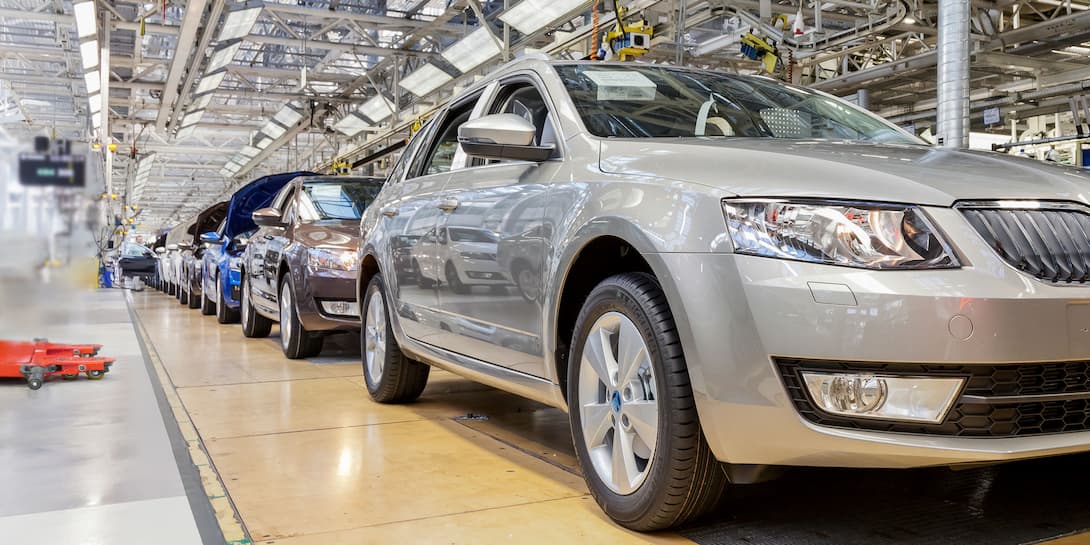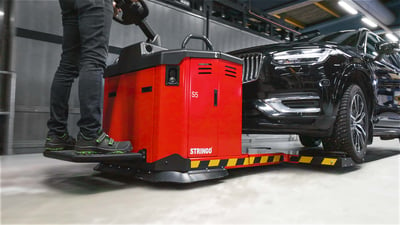Keeping employees safe is at the heart of what we do at Stringo. In this article, our CTO Magnus Grafström shares the philosophy behind our safety features—and reveals some of the developments in store to meet upcoming market demands.
Speed and efficiency are key factors when it comes to vehicle moving, but neither is more important than safety. As Magnus Grafström, CTO at Stringo, puts it, “to our customers, Stringo is first and foremost a safety investment, not simply a utilitarian device to move cars. They’re looking for a way to let their employees move vehicles with a minimum risk of workplace injury and accidents and long-term health problems from bad ergonomics (such as pushing a vehicle by hand). And certain safety elements of Stringo’s vehicle movers are mandatory by law in most countries, such as braking capability and a built-in speed limitation. Others are built into our design, like the powerful press arms. We also offer a range of optional add-ons for extra safety,” he states with pride, knowing that the human element of his design team’s work is paramount.
Five examples of optional Stringo safety features:
- Extra foot guards help avoid the risk of crushing injuries on feet or toes.
- Automatic roller planes with integrated rollover protections prevent the car from rolling over during transport if there are sudden stops or obstacles.
- Sound and light signals alert surrounding staff when the vehicle mover is in operation.
- Ride-on platforms elevate the operator for a better overview and a safer distance to the vehicle.
- Side supports that further protect the operator while on the ride-on platform.
Safety requests can differ a lot from customer to customer and between different countries, says Magnus. “US manufacturers often want prolonged foot guards for extra protection. And right now, we’re working on a new type of fixed ride-on platform for a French customer.”
This dialogue between customers and the research and development team is a major advantage that Stringo has over other solutions as the company sets a standard for safety that has no industrial peer in vehicle moving.
“We’re constantly doing customer listening to hear their feedback. One of our German manufacturing clients did just that and together we innovated a new, very powerful safety update on the foot protection tech,” says Magnus.
Current automotive trends that require extra safety features
Facilities where vehicles need to be moved on sloping surfaces often require additional safety measures to prevent cars from sliding off the vehicle mover.
“Rollover protections let you move cars in a safe and controlled way, even up or down a slope or over an obstacle,” he explains further.
The demand for this solution is growing in the automotive industry, he adds. “New car factories in China are often being built high above the ground level to withstand flash floods. This means the cars need to be taken in and out on ramps. And in the US, up-and-coming EV manufacturers convert old industrial properties with loading ramps to service and delivery centers.”
Rollover protections are also useful for moving heavy vehicles safely. This is a challenge that’s becoming more common as the shift towards electrification continues since EVs tend to weigh more than combustion engine cars. Find out more in our article How to move electric cars quickly and easily in a plant.
Several steps ahead of upcoming safety demands
Magnus and his team are constantly developing and testing new features to meet the ever-changing demands of the market – always putting usability and operator safety first. As the Stringo CTO, can Magnus reveal some upcoming developments.
At the moment, we’re developing our dedicated four-wheel-mover to enable one-button-control operation when loading all four wheels of a car. As we know from our regular Stringo models, this minimises the risk of human error. Operating our machines the right way should be so simple and intuitive that making a mistake becomes almost impossible.”
Magnus also hints that operating a vehicle mover might become more like playing a video game in the near future:
“We see a growing demand for remote controlled vehicle movers. This would reduce the need for human-to-vehicle contact in environments with an increased fire hazard, such as EV testing facilities”.
Stringo safety Q&A
So what have Stringo done to meet the development in the automotive industry?
As the trend is bigger vehicles, for cars with larger tires and conventional four-wheel drive, which make both wheelsets to roll simultaneously, we are able to deliver our Stringo with automatic roller planes, that have integrated rollover protections that work mechanically when a vehicle is entering the roller planes for loading. The protections fold up close to the tires and with the vehicle fully loaded, the protections are raised in an upright position giving outstanding over roll protection for the vehicle towards the Stringo driver.
The automatic roller planes are designed to prevent the risk for the car rolling over during transport if there are sudden stops or obstacles, which otherwise can be an issue with cars with bigger wheels.
Stringo is battery driven. What have we done to secure battery voltage and how do we prevent risks of fires or explosions?
We have a key option and by adding an update to the software in the keypad, the machine is automatically switched off after 30 minutes. Except for safety, this saves on battery charge and increases lifespan. Battery voltage falling below a certain critical level is prevented by the function of the pressarm. If too much of the batteries are discharged, you can only unload a car using the Stringo, not load on another car.
What safety arrangements have we developed for the person driving the Stringo?
Stringo is made to be easy and secure both to handle and to drive. Stringo is equipped with a dual safety system that protects both the operator and the vehicle and we customize our vehicle movers after our customer’s safety requirements. As an example, we have incorporated an additional foot guard on two Stringo 550s. Instead of being located around the drive unit, the foot guard on these specific machines now covers almost half of the vehicle mover.
What is the Hill Hold function?
To be safe driving Stringo on a slope, we have added a Hill Hold function, which works in the same way as the corresponding function on cars. The machine does not release the brake until the torque from the electric motor is higher than the braking force needed to prevent rolling backwards in an incline, even with the car loaded.
What other safety features are there?
Other examples on safety features the Stringo can be equipped with include a horn, so you hear the Stringo coming. We also have vehicle movers that are fitted with a raised rotating warning light, since there are strict safety requirements at that particular customer’s facility, which necessitates that Stringo is visible. By mounting a rod to the machine on top of which the warning light was placed, the vehicle mover can be seen easily.
How can I get help if I have a problem with my Stringo?
Thanks to our distributor and service partner network, we are currently able to reach all continents. Our global presence means that customers can get immediate help if something is not working or needs to be changed, with support by phone or on-site.
Often, customers can get help from someone who speaks their own language. We are aware of that not all people speak English, and when it comes to safety, you must not risk misunderstandings due to language errors. Also therefore, stringo.com is currently available in six languages.
Do you want to learn more about industry trends from Magnus?
Check out this article on four-wheel vehicle movers.





